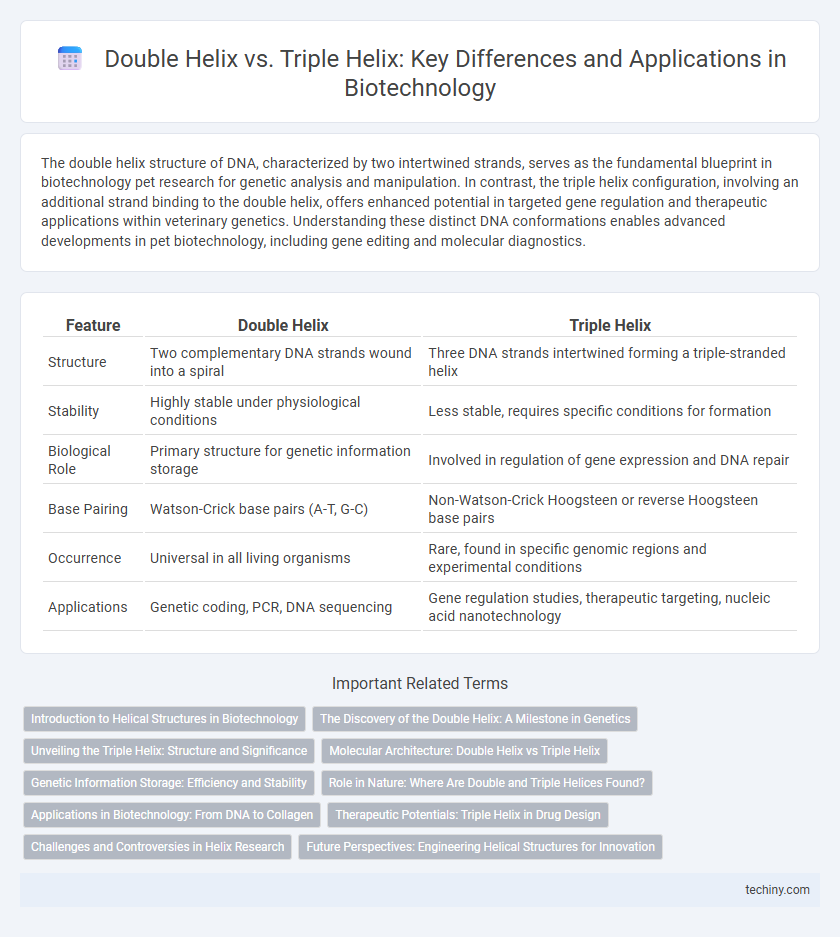The double helix structure of DNA, characterized by two intertwined strands, serves as the fundamental blueprint in biotechnology pet research for genetic analysis and manipulation. In contrast, the triple helix configuration, involving an additional strand binding to the double helix, offers enhanced potential in targeted gene regulation and therapeutic applications within veterinary genetics. Understanding these distinct DNA conformations enables advanced developments in pet biotechnology, including gene editing and molecular diagnostics.
Table of Comparison
| Feature | Double Helix | Triple Helix |
|---|---|---|
| Structure | Two complementary DNA strands wound into a spiral | Three DNA strands intertwined forming a triple-stranded helix |
| Stability | Highly stable under physiological conditions | Less stable, requires specific conditions for formation |
| Biological Role | Primary structure for genetic information storage | Involved in regulation of gene expression and DNA repair |
| Base Pairing | Watson-Crick base pairs (A-T, G-C) | Non-Watson-Crick Hoogsteen or reverse Hoogsteen base pairs |
| Occurrence | Universal in all living organisms | Rare, found in specific genomic regions and experimental conditions |
| Applications | Genetic coding, PCR, DNA sequencing | Gene regulation studies, therapeutic targeting, nucleic acid nanotechnology |
Introduction to Helical Structures in Biotechnology
Helical structures in biotechnology are crucial for understanding molecular interactions and genetic information encoding. The double helix, exemplified by DNA, consists of two complementary strands forming a stable, twisted ladder facilitating replication and transcription. In contrast, the triple helix involves three intertwined strands, influencing gene expression regulation and offering potential in targeted drug delivery and nanotechnology applications.
The Discovery of the Double Helix: A Milestone in Genetics
The discovery of the double helix structure by Watson and Crick in 1953 revolutionized genetics by revealing the molecular basis of DNA replication and heredity. This breakthrough enabled deeper understanding of genetic coding, protein synthesis, and mutation mechanisms. In contrast, the triple helix, a less common DNA structure, plays specialized roles in genetic regulation and has potential therapeutic applications but lacks the fundamental genetic replication significance of the double helix.
Unveiling the Triple Helix: Structure and Significance
The double helix, characterized by two intertwined DNA strands, is fundamental to genetic information storage, while the triple helix involves three strands forming a more complex structure with regulatory and therapeutic potential. Triple helix DNA structures, often stabilized by Hoogsteen or reverse Hoogsteen hydrogen bonds, can modulate gene expression and are explored for targeted gene editing and molecular recognition applications. Understanding the triple helix's unique structural features enhances insights into DNA-protein interactions and advances biotechnological innovations in gene therapy and precision medicine.
Molecular Architecture: Double Helix vs Triple Helix
The double helix structure of DNA consists of two complementary polynucleotide strands twisted around each other, stabilized by hydrogen bonds between base pairs, providing a stable template for genetic information storage and replication. In contrast, the triple helix involves three strands, often formed through Hoogsteen or reverse Hoogsteen hydrogen bonding, which can influence gene regulation and offer potential targets for therapeutic interventions. Understanding the molecular architecture differences between double and triple helices advances insights into DNA stability, protein-DNA interactions, and the development of novel biotechnological applications.
Genetic Information Storage: Efficiency and Stability
Double helix DNA efficiently stores genetic information through complementary base pairing, ensuring high stability and error correction during replication. Triple helix structures, while less common, offer potential for increased storage density but exhibit lower stability due to complex hydrogen bonding and susceptibility to strand displacement. Advances in biotechnology explore triple helix applications for targeted gene regulation, though double helix remains the primary model for genetic information storage efficiency and fidelity.
Role in Nature: Where Are Double and Triple Helices Found?
Double helices are primarily found in DNA molecules, serving as the fundamental structure for genetic information storage in nearly all living organisms. Triple helices occur less commonly and are typically observed in certain RNA structures or specific regions of DNA, playing specialized roles in gene regulation and molecular recognition. These distinct helical forms contribute uniquely to biological processes, with double helices enabling stable genetic encoding and triple helices facilitating regulatory mechanisms in cellular function.
Applications in Biotechnology: From DNA to Collagen
The double helix structure of DNA underpins genetic engineering, enabling precise gene editing, synthetic biology, and biopharmaceutical development. The triple helix, found in collagen, plays a crucial role in tissue engineering, wound healing, and regenerative medicine by providing structural support and enhancing biomaterial strength. Advances in manipulating these helical structures drive innovation in custom biomaterials and therapeutic solutions in biotechnology.
Therapeutic Potentials: Triple Helix in Drug Design
The triple helix structure enhances drug design by providing more specific binding sites and increased molecular stability compared to the double helix, enabling targeted therapeutic interventions. Its unique conformation facilitates the development of novel nucleic acid-based drugs, such as triplex-forming oligonucleotides, which can modulate gene expression with high precision. This improved specificity and stability in triple helix complexes hold significant promise for treating genetic disorders and cancers through advanced biotechnology applications.
Challenges and Controversies in Helix Research
Research in helix structures faces significant challenges in accurately modeling the stability and interactions of Double Helix versus Triple Helix DNA configurations, which impact genetic regulation studies. Controversies persist over the biological relevance of Triple Helix formations in vivo, especially regarding their roles in gene expression and therapeutic targeting. Advances in molecular imaging and computational simulations are essential to resolve conflicting data and validate the functional implications of these complex nucleic acid structures.
Future Perspectives: Engineering Helical Structures for Innovation
Engineering double helix and triple helix structures holds transformative potential in biotechnology, enabling precise control over molecular interactions and stability. Advances in synthetic biology and nanotechnology are driving the design of novel helical biomolecules, expanding applications in drug delivery, gene editing, and bio-sensing. Continued exploration of helical configurations promises innovative therapeutic strategies and multifunctional biomaterials with enhanced performance.
Double Helix vs Triple Helix Infographic

 techiny.com
techiny.com